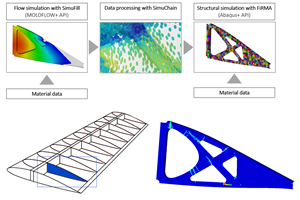Jeff Sloan's first editorial for Composites Technology
A lot of the "old guard"manufacturing processes in the U.S. (metal bending, metal machining, metal casting, etc.) grew up and prospered with the automotive industry, and it was on the coattails of these workhorses that the 20th Century American manufacturing boom rode to prominence.
A lot of the "old guard"manufacturing processes in the U.S. (metal bending, metal machining, metal casting, etc.) grew up and prospered with the automotive industry, and it was on the coattails of these workhorses that the 20th Century American manufacturing boom rode to prominence. Today, steel's long-standing, apparently impervious and venerable reign as the material of choice for vehicles is feeling the pinch on all sides: worldwide demand and price for steel is on the rise, car model life is shrinking and steel is heavier and harder to form than up-and-coming materials, such as composites.
The story is one we've heard many times: It's easier now to concoct a nonsteel part material/tooling/process combination that delivers the strength of steel at a fraction of the weight. Throw in rising fuel prices, diminishing natural resources and growing automotive demand from countries like China, and you have the recipe for protracted and profound change.
So, the industry that effectively built modern America is now traversing new terrain, watching the Japanese Big Three muscle in on the Detroit Big Three, while tier suppliers up and down the chain struggle for profitability. Still, the auto industry is good work if you can get it, and opportunities abound. Composites provide automakers substantial strength-to-weight benefits; autos provide composites processors new applications and a burgeoning market.
Sheet molding compound (SMC) has been here for many years, but recently has seen substantial materials and process changes that paint an even brighter future. Newer on the scene are high-performance thermoplastic composites (oddly misnamed HPPC), which, like SMC, have their eyes on roof, hood and door panels. In this issue, contributing writer Dale Brosius brings you up to date on the latest in cutting-edge SMC automotive applications, including a review of continuing efforts to adapt SMC formulations to changes in the high-temperature painting systems used by auto OEMs (see “Related Content,” at left). You'll also find a report from Dale on composites at the North American International Auto Show (NAIAS), held in mid-January in Detroit.
A little further out on the materials and process limb are the HPPCs, used in the hood and door panels of GM's high-profile concept electric car, the Volt, which made its much heralded debut at NAIAS (see “Detroit Auto Show ….” under “Related Content”). Contributor Peggy Malnati walks you through a novel material/tooling combination, which integrates HPPCs produced by Azdel Inc (Forest, Va.) with the Cage System, an inductive mold heating technology developed by Le Bourget du Lac, France-based RocTool (click “Inside Manufacturing” under “Related Content”).
You and our advertisers
There is a change this month in the system we use to put you in touch with our advertisers. Historically, we used reader service cards (fill out, mail in, wait weeks). More recently, you contacted CT advertisers and other suppliers mentioned in our editorial features via our goComp.biz system, which provided a unique URL for each company, by-passing the old mail-in card. When keyed into your browser, these URLs linked you directly to supplier Web sites - often to product-specific pages within the site. The system also provided a means to contact the company via e-mail to request additional product information. Beginning with this issue, we are evolving reader service one step further. At the bottom of every ad and at the end of many editorial features in this and future issues you will find a single URL. For this issue, it looks like this:
http://www.compositesworld.com/ct/feb/2007
Key that into your browser and it'll take you to a new Web page on the www.compositeworld.com site that lists all of the suppliers mentioned this issue. From there you have one- or two-click access to all you'll need to meet your sourcing needs: Each supplier name on the page is hotlinked to that firm's Showroom, a new feature on the Compositesworld.com site. From a Showroom, you can contact the company directly via e-mail or hotlink to its Home page. We're confident that this much simpler system will make your sourcing task easier - and faster - than ever before. Let us know what you think and how we can help improve this process.
Related Content
Carbon fiber, bionic design achieve peak performance in race-ready production vehicle
Porsche worked with Action Composites to design and manufacture an innovative carbon fiber safety cage option to lightweight one of its series race vehicles, built in a one-shot compression molding process.
Read More“Structured air” TPS safeguards composite structures
Powered by an 85% air/15% pure polyimide aerogel, Blueshift’s novel material system protects structures during transient thermal events from -200°C to beyond 2400°C for rockets, battery boxes and more.
Read MoreImproving carbon fiber SMC simulation for aerospace parts
Simutence and Engenuity demonstrate a virtual process chain enabling evaluation of process-induced fiber orientations for improved structural simulation and failure load prediction of a composite wing rib.
Read MoreCreating a composite battery insert-stud solution for EV trucks
Bossard worked with an OEM and Tier supplier team to meet tight electrical insulation and packaging tolerances while reducing tooling, molding and assembly costs.
Read MoreRead Next
Scaling up, optimizing the flax fiber composite camper
Greenlander’s Sherpa RV cab, which is largely constructed from flax fiber/bio-epoxy sandwich panels, nears commercial production readiness and next-generation scale-up.
Read MoreNext-gen fan blades: Hybrid twin RTM, printed sensors, laser shock disassembly
MORPHO project demonstrates blade with 20% faster RTM cure cycle, uses AI-based monitoring for improved maintenance/life cycle management and proves laser shock disassembly for recycling.
Read MoreUltrasonic welding for in-space manufacturing of CFRTP
Agile Ultrasonics and NASA trial robotic-compatible carbon fiber-reinforced thermoplastic ultrasonic welding technology for space structures.
Read More












